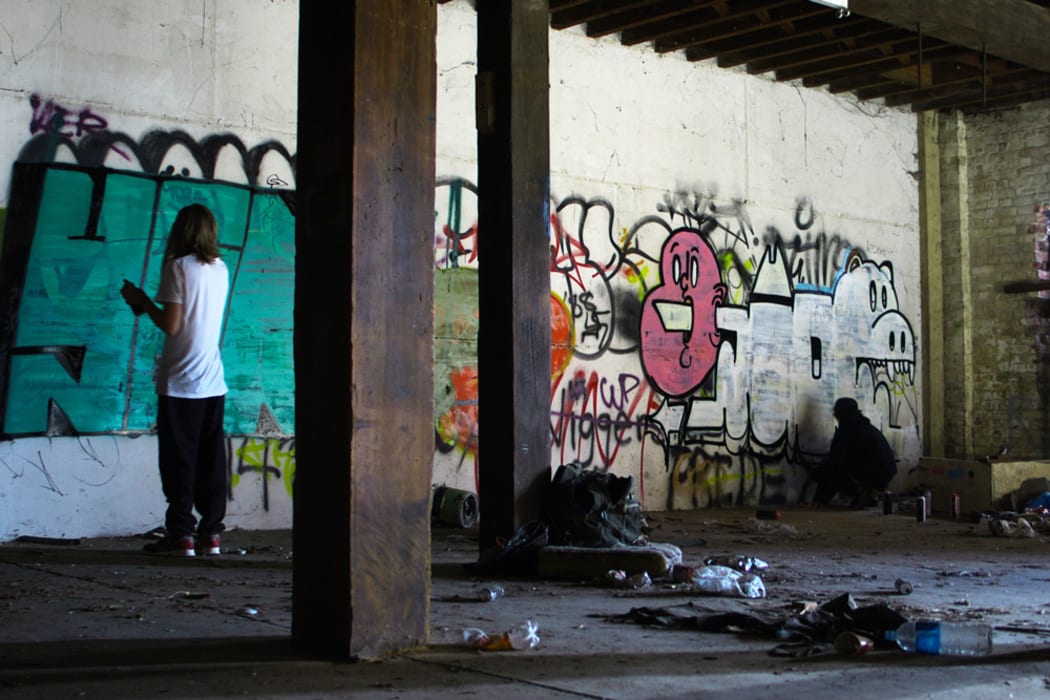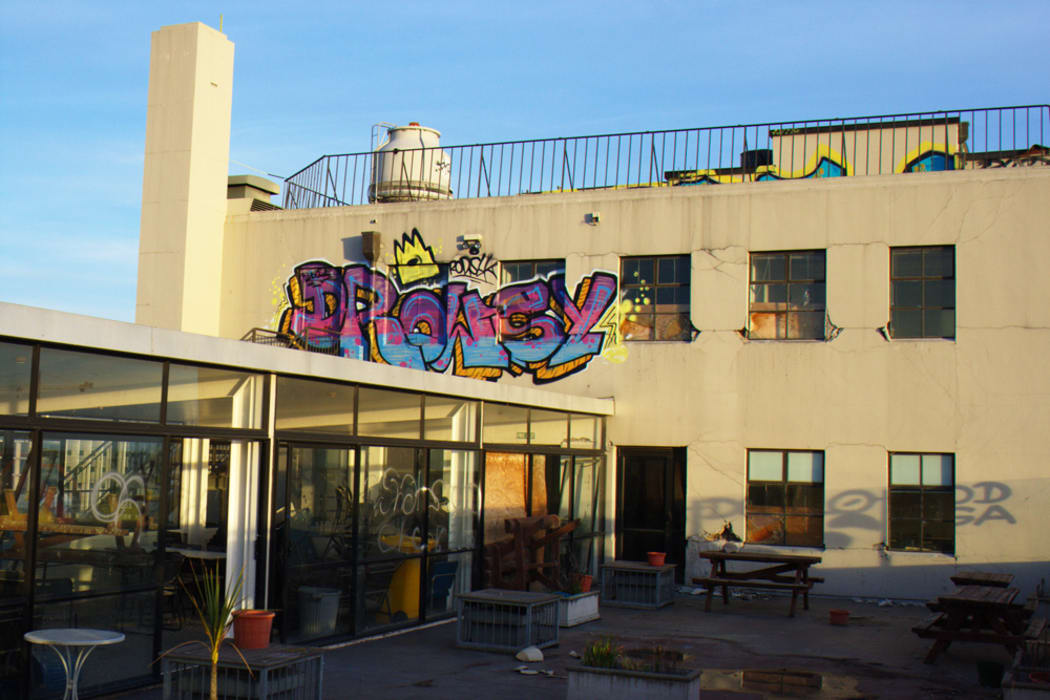Graffiti artists are bringing colour to post-quake Christchurch - and sometimes risking fines and jail time.
The densely tagged buildings along the Wilsons Rd train tracks are a mesmerising labyrinth of colour and lines. It is easy to see why this spot is treasured among Christchurch graffiti artists.
Since the first earthquake hit four years ago, the city has worn its greyness like a uniform. Grey sky, grey roads, grey fences. The only colour on most streets comes from the orange road cones which lie like tombstones where the earth has given in.
This landscape has been the perfect canvas for graffiti artists. Armed with spray cans, they seek a space to make a lasting impression on a city that is slipping away from them.
But marking up quake-damaged buildings is still illegal. Christchurch City Council is out to clean-up any street art that hasn’t been sanctioned, spending almost $800,000 a year to wash away graffiti.
A graffiti artist who is caught and convicted can be up to $2000 in fines or up to seven years in prison. For some, this is simply the risk they take to create their art.
After earthquakes, it felt like the city no longer belonged to the residents. Roads were cordoned off, fences were put up, and people were restricted to their own suburbs. It wasn’t safe to be in the CBD as many buildings had been declared unstable.
They suddenly said you can’t go anywhere anymore, they fenced off blocks of everything.
Graffiti artists are finding space for themselves among the rebuild where they can sign their name and declare that they were here once, exploring and searching, breathing life back into Christchurch.
Marvin*, 20, has just moved to Wellington but he was living in Christchurch at the time of the earthquakes and stayed for the following years. He has been into art and painting for years but only starting doing graffiti after the second earthquake. An art enthusiast and painter, he is passionate about the place of underground graffiti in the Christchurch rebuild.
Looking out from under his long hair, with a cigarette caught between his lips, he looks the picture of a renegade street artist. For him, it all started with exploring the buildings that were partially destroyed and declared uninhabitable after the earthquakes.
There is an undertone of frustration as he explains the effects of going through the earthquakes when he was only 14. He and the other two artists I talked to were in their early teens when the earthquakes hit. Just as they reached the age where most young teens begin to explore their city and experience their first taste of freedom this was all cut off from them.
“They suddenly said you can’t go anywhere anymore, they fenced off blocks of everything,” says Marvin.
The first time he wielded a spray can was when he and a friend were exploring the abandoned Holiday Inn on Oxford Terrace when they decided it would be cool to leave their mark behind.
Marvin says that just by being in these buildings they are reclaiming them.

Photo: Julian Vares
Marvin’s best friend, Aubrey*, has been his partner in all things art and graffiti during their teenage years. Although he has recently moved to Wellington, Aubrey has spent the last few years in Christchurch exploring red-stickered buildings in the CBD by the cover of night.
Aubrey started taking spray paint in his backpack when he went out to explore after seeing just how much space there was to paint. He started writing his name on big, blank empty walls that “no one cared about”.
“They were doomed in the first place to be destroyed.”
Aubrey says that there are certain places already ruined that they know are going to be destroyed. It is hard for these artists to see any negative consequences of their graffiti when these spaces aren’t being used for anything else.
Graffiti on red-stickered buildings is still a crime and both Marvin and Aubrey tell different tales of being arrested for tagging. In Aubrey’s case, he was arrested simply for having spray paint in his backpack. He says they charged him for having “implements of graffiti”.
All the artists spoken to for this story understand that what they do is illegal but they make no mention that this will ever stop them doing it.
Graffiti has become a way for people like Marvin and Aubrey to feel a part of their city again by both exploring it and decorating it with patches of unique art. Marvin describes the desolation in the city’s business district as an opportunity to experience the city in a new way.
“Not many people get to experience living in a city like that.”
People are angry because they are afraid. They want things to be the way they want. It’s not me that they’re angry at.
Not all Christchurch residents see graffiti as a way to reclaim corners of the city. One of the main concerns people living in post-quake Christchurch was the rise of graffiti, according to a 2013 survey.
Claire Phillips, manager of the council’s community support team, says that any graffiti is a problem and Christchurch’s community is invested in its removal.
The council spends $66,000 a month on a contractor that removes graffiti. The rest is cleaned up by 1000 volunteers.
Phillips says that the emergence of legal street art around the city has dissuaded some would-be “taggers”.
“They see that the legitimate art-form is something they would be interested in, not just the permission-less vandalism. There’s a culture shift in tagging being cool.”
“There is a difference between tagging your initials on a fence and actually embarking on a piece of artwork where people want it,” Phillips says.
Although it is clear that no one wants illegal tagging on their property, the graffiti artists have said they use unused spaces on buildings in town where people are unlikely to see or be negatively affected by them.
Phillips says any work painted on someone’s property without permission is vandalism. This definition continues to cover red stickered buildings in Christchurch.
Marvin says the council and local politicians see graffiti as a sign of disorder and moral degeneration; a force that is threatening the way they want things to be.
“People are angry because they are afraid.”
“They want things to be the way they want. It’s not me that they’re angry at.”

Photo: Julian Vares
In some cases the legal murals look similar to those considered illegal vandalism by the council. They are perhaps more beautiful in a traditional sense, but rarely is there the same sense of street personality as you get in the underground works that showcase the artist’s name or phrase.
Aubrey says people “get” the legal street art because they know it’s “art”. He says if he was to tag in the same style as the commissioned pieces are done in then no one would talk about it.
Wilson*, 17, creates huge graffiti murals on Christchurch buildings, sometimes with permission, but more often without it. He says that since being exposed to street art the public doesn’t want to settle for the style of graffiti that’s simply letters and names anymore. There seems to be a certain style to graffiti that has negative connotations.
There is a market for street art, but only a specific style and only in legally commissioned spaces.
One thing that all these graffiti artists have in common is a shared love for art itself. Aubrey says he paints and draws every day without doing graffiti and Marvin had been practising art long before he started doing graffiti.
Marvin says graffiti is a way of communication, both on an artist to artist level and from the artists to the public.
“It’s not communicating to the people who won’t open their minds to listen to it.”
Wilson sees a future in graffiti for himself but fears that the police will raid his house looking for evidence. Despite this he continues to paint Christchurch with sprawling murals of colour.
“I’ll always keep doing it one way or another.”
*Names changed
Video shot and edited by Julian Vares.
This content is brought to you with funding support from NZ On Air.

